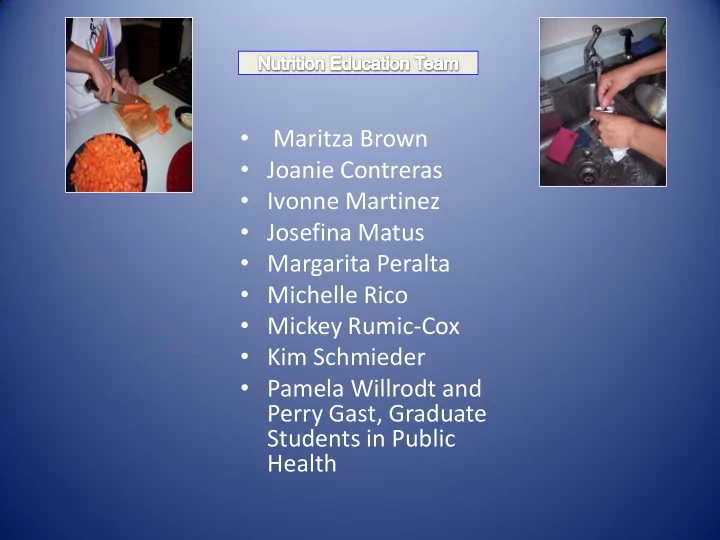

• Maritza Brown • Joanie Contreras • Ivonne Martinez • Josefina Matus • Margarita Peralta • Michelle Rico • Mickey Rumic-Cox • Kim Schmieder • Pamela Willrodt and Perry Gast, Graduate Students in Public Health
The Extension Food and Nutrition Education Program (EFNEP) provides individuals, families, and communities with the knowledge and skills that empower them to make informed choices about food and other lifestyle issues that support their physiological health and economic and social wellbeing.
• Reached 531 adults & 6,700 youth • Six 1-2 hour nutrition classes • Pre/Post Surveys of Adult Participants: – 64% improved planning meals and reading labels – 69% improved food safety practices – 40-45% improved in eating fruits and vegetables • What about behavior beyond the duration of the program?
• Pre/Post plus Three-month Follow-up • Intervention (N=49), Control (N=36) • Behavior checklist, 24-hour Food Recall • Stages of Change • Marital/Partner Relationship Quality • Body Mass Index • Barriers to Change
Intervention • Paraprofessionals delivered a series of six nutrition education classes • Each class lasts approximately 1 ½ hours • Eating Right is Basic, curriculum developed by Michigan State University • Classes cover topics such as : • General nutrition • Portion size • Label reading • Goal setting • Stretching food dollars • Food safety • Physical activity • The Food Pyramid and Nutrition Guidelines for Americans is used as the basis for instruction • Social Learning Theory is the theoretical foundation
Method • Participants recruited from ESL and ELL classes (N = 81) • Intervention group (N = 45) received EFNEP lessons in fall of 2008 • Control group (N = 36) received EFNEP lessons in late winter of 2009 • Behavioral checklist & 24-hour Food Recall were administered at three time periods (pre/post, and three month follow-up): • Time 1: October 2008 • Time 2 : December 2008 • Time 3: March 2009 • Surveys provided in English and Spanish • All participants completed a consent form • Body Mass Index calculated from height and weight
Demographics • Women made up 90% of sample • Age-range of 18 to 65 years, • Average age of 35 years • Most participants identified themselves as Hispanic (95%). • One-third of the participants had a BMI between 25 and 30, • Nearly half (48%) had a BMI above 30 • Average BMI was 30.5 • Majority of respondents (70%) reporting income were below the federal poverty level.
Results: Behavior Checklist Behavioral Checklist Results – Time 1 to Time 3 Intervention (N=35) Control (N=31) ___________________ _____________________ Checklist Item Mean Mean t -value Mean Mean t -value Time 1 Time 3 Time 1 Time 3 Meal planning 3.29 3.71 -2.23* 3.52 3.59 -.284 Comparing 3.70 4.24 -2.67* 3.79 4.14 -2.17* food prices Running out 2.09 1.94 0.87 2.20 2.64 -1.70 of food Shopping 3.26 3.94 -3.70* 3.04 3.30 -1.07 with list Letting meat 1.77 1.71 0.40 1.92 2.15 -1.03 & dairy sit out Thawing 3.00 2.39 2.03* 3.32 3.21 .406 frozen foods at room temperature Thinking 3.03 4.21 -5.13** 3.54 3.82 -1.44 about nutrition Cooking 2.48 2.67 -0.73 1.88 2.58 -2.54* without salt Reading 2.44 3.32 -3.77** 1.93 2.57 -2.31* food labels Feeding 2.93 4.11 -3.86** 3.68 3.75 -.24 children in AM Exercising 3.03 3.82 -3.86** 3.64 3.00 1.55 * p < .05, ** p < .01
Results: 24-hour Food Recall Table 2 24-Hour Food Recall Results – Time 1 to Time 3 Intervention (N=35) Control (N=31) ____________________ _____________________ Food Group Mean Mean t -value Mean Mean t -value Time 1 Time 3 Time 1 Time 3 Grains 5.24 4.86 0.77 2.40 4.90 -3.5** Fruits 1.20 0.94 0.88 0.68 1.39 -2.12* Vegetables 2.68 2.47 0.43 0.61 1.45 -2.6** Milk & Dairy 2.27 1.83 1.36 0.85 1.22 -1.67 Meat & Beans 3.20 3.07 0.28 2.10 2.39 -0.98 Other 1.31 1.11 0.63 1.71 2.48 -1.01 * p < .05, ** p < .01
Relationships In general, does your partner make it easier or harder for you to maintain a healthy relationship? • 7% He/she makes it much harder • 2% He/she makes it moderately harder • 8% He/she makes it slightly harder • 23% Neutral • 8% He/she makes it slightly easier • 12% He/she makes it moderately easier • 40% He/she makes it much easier Correlation with BMI = - .26* p<.05
Relationships “My husband and daughter are very picky eaters. It’s had to satisfy them with healthier foods.” “My husband goes to work out every morning, but I don’t like to exercise.” “We all need to want to do this.” “I am single, low -income at present and therefore do very little cooking. I have begun sharing dinner with a friend a couple of times per week, alternating who cooks. We make a real effort to plan healthier meals.” “My family doesn’t have time to sit down and eat a home cooked meal, so we eat a lot of fast food.” “The biggest challenge for me and my family is the traditional food and the way of cooking. We have a lot of fat in our food.” “(My husband) likes to go out to eat a lot.”
Readiness for Change • 7% have made no attempt to change to a healthy diet in past six months • 8% might make plans over next six months • 18% tried to make change over past six months but failed • 36% definitely plan to make change over next six months • 20% have made change in past six months • 12% have been on successful healthy diet for more than six months
Discussion • Increase in skills such as reading labels and comparing prices • Increase in reported behaviors such as “exercising” and Feeding children in morning • More conscientious about food safety and nutrition • Limitations on 24-hour Food Recall Results • Next approach — supportive messages For more information contact: Dan McDonald, Ph.D at mcdonald@cals.arizona.edu
Recommend
More recommend